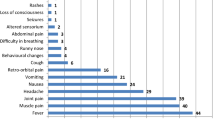Abstract
Ethylenediaminetetraacetic acid (EDTA)-dependent pseudothrombocytopenia (PTCP) is the phenomenon of a false low platelet count reported by an automated haematology analyzer due to in vitro aggregation of platelets. This aggregation is due to the interaction between antibodies and EDTA-dependent crypt antigens on platelets. We observed a new born child whose mother was diagnosed with transient PTCP due to transplacental transmission of maternal immunoglobulin G antibodies during pregnancy. Conclusion: Although maternal–neonatal PTCP is rare, it is important to consider this phenomenon as a cause of trombocytopenia, as it can result in unnecessary diagnostic workup and treatment.


Similar content being viewed by others
References
Bartels PCM, Schoorl M, Lombarts AJPF (1997) Screening for EDTA-dependent deviations in platelet count and abnormalities in platelet distribution histogram in pseudothromocytopenia. Scand J Clin Lab Invest 57:629–636
Bizarro N (1995) EDTA-dependent pseudothrombocytopenia: a clinical and epidemiological study of 112 cases, with 10-year follow-up. Am J Hematol 50:103–109
Casonato A, Bertomoro A, Pontara E, Dannhauser D, Lazzaro AR, Girolami A (1994) EDTA dependent pseudothrombocytopenia caused by antibodies against the cytoadhesive receptor of platelets gb IIb/IIIa. J Clin Pathol 47:625–630
Chiurazzi F, Villa MR, Rotoli B (1999) Transplacental transmission of EDTA-dependent pseudothrombocytopenia. Haematologica 84:664
Froom P, Barak M (2011) Prevalence course of pseudothombocytopenia in outpatients. Clin Chem Labmed 49:111–114
Jacobs J, Tricot G, Verwilghen RL (1986) Pseudotrombocytopenie door trombocytenagglutinaten (EDTA-pseudotrombocytopenie). Ned Tijdschrift voor Geneeskunde 130:1643–1646
Malek A, Sager R, Kuhn P, Nicolaides KH, Schneider H (1996) Evolution of maternofetal transport of immunoglobulines during human pregnancy. Am J Reprod Immunol 36:248–255
Onho N, Kobayashi M, Hayakawa S, Utsunomia A, Karakawa S (2012) Transient pseudothrombocytopenia in a neonate: transmission of a maternal EDTA-dependent anticoagulant. Platelets 23(5):399–400
Shreiner DP, Bell WR (1973) Pseudothrombocytopenia: manifestation of a new type of platelet agglutinin. Blood 42:541–549
von dem Borne AE, Verheugt FW, Oosterhof F, von Riesz E, de la Rivière AB, Engelfriet CP (1978) A simple immunofluorescence test for the detection of platelet antibodies. Br J Haematol 39(2):195–207
Conflict of interest
The authors declare that they have no conflict of interest.
Author information
Authors and Affiliations
Corresponding author
Rights and permissions
About this article
Cite this article
Korterink, J.J., Boersma, B., Schoorl, M. et al. Pseudothrombocytopenia in a neonate due to mother?. Eur J Pediatr 172, 987–989 (2013). https://doi.org/10.1007/s00431-012-1892-4
Received:
Accepted:
Published:
Issue Date:
DOI: https://doi.org/10.1007/s00431-012-1892-4




